WHAT'S NEW ACROSS THE WORLD
Select date in side bar to go a What's
New of previous issues
| What's New ©by
Laif DeMason
Winter is upon us and hobbyists are spending more
time inside with their fish tanks. Many cichlid enthusiasts are, as always,
looking for something a little different. Many seek something new or exclusive,
maybe a newly-discovered fish or maybe the reappearance of a fish long
forgotten. This leads to the question: how many suitable cichlids still
await discovery? The normally harvested areas of the world are fairly well
explored, only a few novel varieties can be expected from them in the future,
but there are still many areas in the tropical Americas and Africa that
remain obscured from the eyes of aquarists. Unfortunately, such out of
the way places often lack commercial exporters to provide wild caught items
for sale. There can be many and varied reasons for the lack of attention
but, hopefully, the new and different will slowly emerge!
Here’s “what’s new” on the cichlid scene: |
Lake Tanganyika
The popularity of certain groups of Tanganyikan cichlids seems to be
shifting yet again. An increase in the demand for Opthalmotilapia
and Cyathopharynx varieties has been noticeable. Hobbyists have
also been asking for adult Tropheus, as well. Fortunately, collecting
continues from all points along the lake. Exporters have been complaining
about the increased and chronic power shortages, along with the price of
fuel and logistics.
|
what's new: Lake Tanganyika
|

From the Zambian shores of Lake Tanganyika, Petrochromis
macrognathus is a challenging, yet recently popular item for hobbyists. |

Collected in Tanzania and often exported as Lepidiolamprologus
nkambae, this fish is Lepidiolamprologus kendalli. |
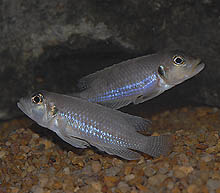
Reportedly from central Tanzania, this Lamprologus
cf. stappersi “Neon” sports an iridescent blue ventral streak. |

Collected off Kala Island, Tanzania, this Tropheus
moorii sports a blue dorsal fin, a green body, and a plum colored head. |
Lake Malawi
Exports from the usual places around Lake Malawi continue but seem to
be spotty compared to the previous quarter. Tastes also seem to be shifting,
with more emphasis being placed on colorful haplochromines such as Protomelas,
as well as some predatory species. Hobbyists are also revisiting some mbunas,
such as the Metriaclima zebra-complex. Only time will tell which
Malawi species group will remain a lasting favorite.

Recently exported from Gome, Malawi, Copadichromis
sp. “yellow jumbo” arrived as sub-adults and are not fully grown. This
is typical for certain Copadichromis species. |

Infrequently collected in the wild and almost never
in color, this predatory Champsochromis caeruleus was captured at
Itungi Port, Tanzania. |

Collected in Mozambique, Metriaclima sp. “kingsizei
Lumlaulo” is a jumbo variety compared to “kingsizei” from other locales. |

Another fish rarely exported from Tanzania, Mylochromis
ericotaenia Manda sports vertical bars and the typical diagonal stripe. |
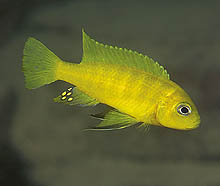
This small species, Cynotilapia sp. “lion Ntekete,”
occurs along the Malawi east coast and was previously known as Pseudotropheus
sp. “dwarf gold.” Photo by A. Konings. |
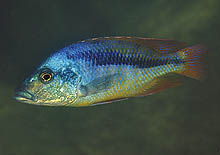
Yet another not-so-often seen fish from Tanzania,
Mylochromis
epichorialis is a recent arrival. Photo by A. Konings. |
Lake Victoria
Victorian cichlids are currently only available from breeders. However,
over time, purchases made by both retailers and hobbyists have whittled
down the demand to a handful of colorful varieties. This means that many
of the bred Victoria basin species have no commercial demand and, therefore,
will disappear from many breeding facilities. This is especially true in
Florida, where the recent real estate boom has decreased available farming
acreage. Marginal species, like many Victorian cichlids, will soon disappear
from commercial channels, perhaps never to be collected nor re-established
again in the future.
|
what's new: Lake Victoria
|

Bred in a few places, including Florida, Haplochromis
“argens” was available several years ago but is no longer available to
hobbyists on a commercial basis. Photo by O. Seehausen. |

Another oft-overlooked species, Neochromis omnicaeruleus
(previously Haplochromis ‘blue scraper’) is not available through
commercial channels. Photo by O. Seehausen. |
Neotropics
The collecting season is underway in South America, with spotty shortages
of certain species being reported initially. Popular species still seem
to be the usual favorites, such as Apistogramma, discus, pike cichlids,
and geophagines. Interest in some of the rarer varieties of Central Americans
is evident, as well. There seems to be a little bit of something for everyone.

Collected from the Xingu area of Brazil, Cichla
sp. Xingu may prove to be a new species. Photo by O. Lucanus. |

Originally from the Rio Uruguay, Crenicichla minuano
grows to a length of 7"; on the small side for a pike cichlid! Photo by
O. Lucanus. |
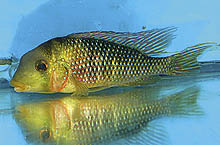
Collected in the eastern state of Cerro Largo, Uruaguay,
Gymnogeophagus
cf. labiatus “blue Yerbalito” is one of the many beautiful labiatus-like
species. Photo by J. Rapps. |
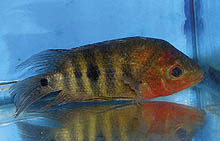
Collected in muddy habitats behind an island in Lake
Nicaragua, Amphilophus sp. ‘islestas” sports a red head. Possibly
an undescribed species, it does not inhabit the typical A. citrinellus
territory. Photo by J. Rapps. |
Select date in side bar to go a What's
New of previous issues
|















